Charges in Kansas Water Park Death
March 28, 2018 —
David Suggs - CDJ STAFFCaleb Schwab, a 10-year old boy was killed by decapitation on a water slide at a Kansas City water park, Schlitterbahn in 2016. Thirteen other people had suffered injuries on the ride prior to Caleb’s death ranging in severity from broken toes to concussions. Schlitterbahn employees have since claimed that park officials covered up past occurrences of water slide injuries.
Three people have been indicted in this case according to a CNN report by Marlena Baldacci, Sheena Jones and Hollie Silverman. Jeffrey Henry, the co-owner of the Schlitterbahn water park, Tyler Austin Miles, the park’s former director of operations and John Schooley.
Charges include second-degree murder, involuntary manslaughter, aggravated battery and aggravated child endangerment. Caleb suffered a fatal injury when the raft that he and the two women who were riding with him became airborne and contacted the netting attached overhead.
Investigators have found maintenance issues and ride design flaws that violate safety standards leading to lack of prevention of rafts becoming airborne during the ride. Caleb’s family will receive nearly $20 million in the settlement. Caleb’s father Scott, released a statement about placing full trust in the Attorney General Derek Schmidt who is presiding over the investigation and indictments.
Read the court decisionRead the full story...Reprinted courtesy of
HOA Foreclosure Excess Sale Proceeds Go to Owner
August 15, 2022 —
Ben Reeves - Snell & Wilmer Real Estate Litigation BlogOver the last few years, the Arizona Court of Appeals wrestled with the question of who should receive the excess proceeds from a foreclosure sale. We’ve blogged about some these past unreported decisions
here and
here. Those decisions, somewhat inexplicably, required excess sale proceeds to be paid to senior creditors. As we noted at the time, these unreported (and non-precedential) decisions did not seem to make much sense in the context of debtor/creditor rights. Thankfully, a reported opinion finally sets the record straight. Excess sale proceeds should be paid downstream.
In
Tortosa Homeowners Assoc. v. Garcia, et al., No. 2 CA-CV 2021-0114 (Ct. App. Aug. 1, 2022), the Court of Appeals held that after the foreclosing lienholder is paid in full, then the excess sale proceeds should be paid to claimants in the order of their priority after the foreclosing lienholder. In other words, if a junior lienholder forecloses, then any creditors behind (i.e., junior to) the foreclosing creditor should be paid, and if all such creditors are paid, then the rest should be given to the owner. Creditors senior to the foreclosing creditor should not be paid anything from the foreclosure sale. This makes sense from a policy perspective, because the senior creditor retains its lien against the property and the bidder presumably took the presence of the senior lien into account when it made its bid for the foreclosed property.
Read the court decisionRead the full story...Reprinted courtesy of
Ben Reeves, Snell & WilmerMr. Reeves may be contacted at
breeves@swlaw.com
Real Estate & Construction News Round-Up (11/16/22) – Backlog Shifts, Green Battery Storage, and Russia-Ukraine Updates
December 05, 2022 —
Pillsbury's Construction & Real Estate Law Team - Gravel2Gavel Construction & Real Estate Law BlogThis week’s round-up explores backlog shifts in the nonresidential construction sector, updates from the ongoing war between Russia and Ukraine, lithium-ion battery storage issues in New York City, and more.
- According to Associated Builders and Contractors, construction backlog fell back below the reading observed in February 2020, largely due to a decline in the commercial and institutional sector. (Sebastian Obando, Construction Dive)
- Amid celebration after retaking Kherson from retreating Russian troops, the Kremlin targeted critical infrastructure before withdrawing. (Michael Kern, Oil Price)
- Real estate value in the metaverse is rising, given that virtual land can be built upon to create unique branding experiences that lend to advertising, marketing, socializing, and entertainment. (Evan Bourke & Sarah Hedley Hymers, Euronews)
Read the court decisionRead the full story...Reprinted courtesy of
Pillsbury's Construction & Real Estate Law Team
20 Years of BHA at West Coast Casualty's CD Seminar: Chronicling BHA's Innovative Exhibits
May 03, 2018 —
Beverley BevenFlorez-CDJ STAFFThe Bert L. Howe & Associates, Inc., (BHA) exhibit has been a fixture at West Coast Casualty's Construction Defect Seminar since the mid-1990's. Through the years, BHA has updated their display, but no matter what year, you could count on the BHA exhibit to provide a not-to-be-missed experience.
2008-BHA's sleek, rear projection display includes a screen that promotes the firm's capabilities that can be seen throughout the exhibit hall. This would be one of many innovations BHA has brought to the West Coast Casualty seminar.
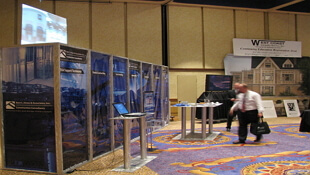
2009-With the success of the rear screen projection, BHA adds additional monitors to provide attendees with more information about BHA.
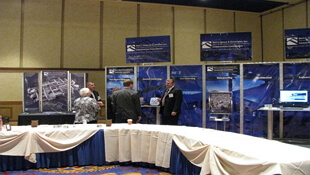
2010-BHA adds an interpretive professional development exhibit targeted to Building Envelope issues allowing adjusters and other non-construction professionals hands on access to the systems and components at the heart of many related such claims.


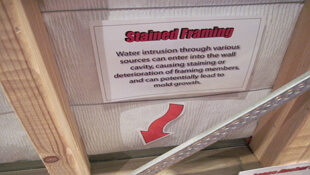
2011-BHA's Swing for Charity challenge is born.

2012-Always innovating, BHA expands its rear projection and professional development offerings to West Coast attendees.

2013-BHA showcases additional capabilities with a twenty-four foot, custom, convex, immersive video experience.

2014-BHA adds an iPhone display to give a hands-on demonstration of their data collection methods.

2015-BHA's twenty-four foot , custom, convex, immersive video experience was elevated with two additional rear projection screens, reflecting BHA's newest capabilities and services.

2016-BHA dazzles attendees with their new exhibit comprised of more than 15 integrated, high definition, LCD displays. iPads are stationed on tables to conveniently demonstrate BHA's data collection processes.

2017-BHA's Swing for Charity Golf Challenge raised $2,225.00 for the National Coalition for Homeless Veterans and $1,900 for Final Salute.
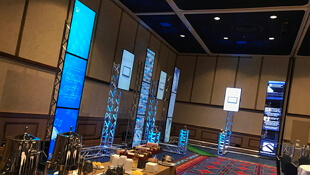
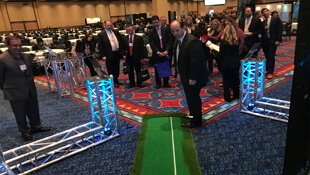
Read the court decisionRead the full story...Reprinted courtesy of
Paul Tetzloff Elected As Newmeyer & Dillion Managing Partner
June 03, 2019 —
Newmeyer & Dillion LLPNewmeyer & Dillion LLP, a prominent business and real estate law firm, selected Paul Tetzloff as the firm's Managing Partner. His term began on January 1, 2019. A business litigator, Tetzloff will now oversee the firm's strategic plan and manage the firm's day-to-day business affairs.
"The Firm is incredibly fortunate to have Paul stepping into the role as Managing Partner. His energy, intelligence, leadership, and drive make him uniquely qualified to lead this Firm for years to come," said former Managing Partner Jeff Dennis. "I am excited to watch where the Firm is headed – we have such an amazing opportunity to continue to develop to even greater heights, and Paul will be a huge part of making that happen."
Active in his community, Tetzloff sits on the board for HomeAid Orange County and the Marine Raider Association.
Tetzloff is succeeding Dennis, who served in the role from 2012 to 2018. "Jeff was our managing partner for seven years and he did an outstanding job. We owe Jeff a debt of gratitude for his service," said Tetzloff of his predecessor. "I'm looking forward to continuing to build on the groundwork laid to help the firm reach new levels in the years to come."
Dennis' leadership allowed the firm to grow substantially under his tenure, including opening a Las Vegas, Nevada office and establishing thriving practice areas throughout various industries. Dennis will focus his energy on overseeing the firm's growing Privacy and Data Security practice.
Paul Tetzloff
paul.tetzloff@ndlf.com
Practice Areas
Business Litigation
Construction Litigation
Real Estate Litigation
About Newmeyer & Dillion
For almost 35 years, Newmeyer & Dillion has delivered creative and outstanding legal solutions and trial results for a wide array of clients. With over 70 attorneys practicing in all aspects of business, employment, real estate, privacy & data security and insurance law, Newmeyer & Dillion delivers legal services tailored to meet each client's needs. Headquartered in Newport Beach, California, with offices in Walnut Creek, California and Las Vegas, Nevada, Newmeyer & Dillion attorneys are recognized by The Best Lawyers in America©, and Super Lawyers as top tier and some of the best lawyers in California, and have been given Martindale-Hubbell Peer Review's AV Preeminent® highest rating. For additional information, call 949.854.7000 or visit www.ndlf.com.
Read the court decisionRead the full story...Reprinted courtesy of
Kentucky Court Upholds Arbitration Award, Denies Appeal
June 15, 2011 —
CDJ STAFFThe Kentucky Court of Appeals has ruled in Lake Cumberland Community Action Agency v. CMW, Inc. affirming the arbitration award. CMW, Inc. was responsible for the construction of a facility to be used for pre-school students and the housing of Alzheimer patients and senior citizens. An agreement was made that any disputes would be heard by an arbitrator selected by the construction industry.
�The plaintiff alleged that there were design and construction defects in the building trusses, violation of the Kentucky Building Code, and problems with the HVAC system. The arbitrator awarded $106,000 to the plaintiff which then sought to vacate the award. The circuit court upheld the arbitrator’s decision.
�The Court of Appeals found that there was no basis for rejecting the arbitrator’s decision, noting “there is nothing to show that there was any fraud or bias on the part of the arbitrator.” The appeals court, with all three judges concurring, upheld the arbitration award.
�Read the court’s decision
Read the court decisionRead the full story...Reprinted courtesy of
Pre-Suit Settlement Offers and Construction Lien Actions
July 21, 2018 —
David Adelstein - Florida Construction Legal UpdatesIt is unfortunate, but in certain matters, a construction lien foreclosure action is not actually driven by the principal amount in dispute. Oh no. Rather, it is driven by attorney’s fees. That’s right. Attorney’s fees. This is true even though Florida applies the significant issues test to determine the prevailing party for purposes of attorney’s fees. However, oftentimes the prospect of attorney’s fees is enough for parties to fear that exposure.
There is a 1985 Florida Supreme Court case that I like to cite if applicable, C.U. Associates, Inc. v. R.B. Grove, Inc., 472 So.2d 1177, 1179 (Fla. 1985), that finds, “in order to be a prevailing party entitled to the award of attorney’s fees pursuant to section 713.29 [a construction lien claim], a litigant must have recovered an amount exceeding that which was earlier offered in settlement of the claim.” Accord Sullivan v. Galske, 917 So.2d 412 (Fla. 2d DCA 2006) (explaining that although contractor is receiving a judgment in his favor, he may not be the prevailing party if the homeowner offered to settle prior to the lawsuit for an amount equal to or greater than the award in the judgment).
Read the court decisionRead the full story...Reprinted courtesy of
David Adelstein, Kirwin NorrisMr. Adelstein may be contacted at
dma@kirwinnorris.com
Form Contracts are Great, but. . .
November 12, 2019 —
Christopher G. Hill - Construction Law MusingsRecently I was discussing the ConsensusDOCs with a colleague and friend and had a revelation. These forms are used often (though somewhat less than their AIA counterparts and less than they should be used). Quick disclaimer: I have been a part of a couple of drafting committees for ConsensusDOCs and am friends with Brian Perlberg, general counsel to the drafting effort.
Some of the reason that these forms are so widely used is that they can be applied in a general way to almost any situation. Both sets of forms have documents for small and large jobs. Both have forms for Contractor/Owner and Contractor/Subcontractor. In short, a form document exists for about any scenario.
I am writing now to let you know that while forms are great, they are just that. . . forms. Like with any set of forms, they need to be “tweaked” for your particular project. In my opinion they both have great clauses in them, and both have some flexibility built in (ConsensusDOCS more at the moment than the AIA forms). At the very least, construction professionals need to use this flexibility to conform the documents to their particular situation and do so within the documents themselves and not with addenda that “strike” or “modify” particular clauses.
Read the court decisionRead the full story...Reprinted courtesy of
The Law Office of Christopher G. HillMr. Hill may be contacted at
chrisghill@constructionlawva.com




































































